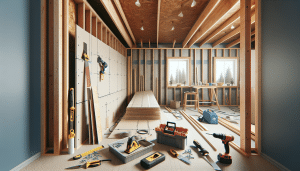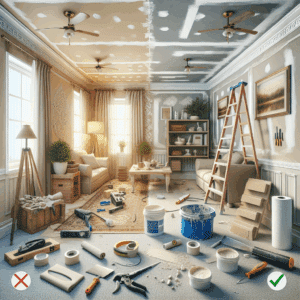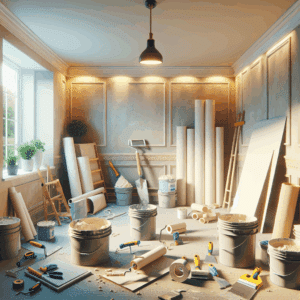Fresh drywall changes how a room feels. Corners look sharper, light spreads evenly, and paint finally behaves. If you’ve ever stared at a wavy seam or a pockmarked patch, you already know—professional drywall work isn’t just about hanging sheets; it’s about the finish that makes everything else look right. This guide walks homeowners across Salt Lake County, Davis County, and Utah County through what “professional” really means, step by step, with plain-language tips and a few shop-floor secrets along the way.
Contents
- 1 What “professional drywall installation” actually includes
- 2 Step 1 — Framing checks: the quiet work that saves the day
- 3 Step 2 — Hanging boards so seams vanish later
- 4 Step 3 — Taping: paper, mesh, hot mud, and when to use what
- 5 Step 4 — Coating and feathering: wide is kind
- 6 Sanding without the snowstorm
- 7 Ceilings and lighting: why glare lines show everything
- 8 Sound control and fire code—quick notes that matter
- 9 Repairs vs. replacements: a small contradiction we’ll explain
- 10 Finishes, textures, and paint readiness
- 11 Seasonal and local quirks across the Wasatch Front
- 12 DIY vs. hiring pros—fair questions, honest answers
- 13 Tools we trust (because you asked)
- 14 Red flags when hiring—save this checklist
- 15 Serving Salt Lake, Davis, and Utah counties—with clean, predictable results
- 16 Ready for walls that look right—even in harsh light?
What “professional drywall installation” actually includes
Here’s the thing: true drywall work is a system. It starts with layout and framing checks, moves through hanging and fastening, and ends with finishing, sanding, and priming. Skip one piece—or rush it—and you’ll see it later in every glare line and shadow stripe.
- Layout: Stud spacing confirmed; backing added behind seams and inside corners.
- Hanging: Sheets run horizontally for fewer seams; factory edges meet factory edges where possible.
- Fastening: Screws set just below the paper without tearing it—snug, not cratered.
- Taping & coating: Joints get three passes; corners get proper bead; fasteners get covered cleanly.
- Sanding & priming: Surfaces are feathered wide, then sealed so paint doesn’t flash.
Sounds simple. It isn’t. But it is repeatable when the process stays tight.
Step 1 — Framing checks: the quiet work that saves the day
Drywall hides a lot, but it won’t hide crooked studs. We use a long straightedge and a string line to spot humps and dips. A proud stud gets planed; a hollow bay may need a shim. You might think this is overkill. Honestly, it’s the five minutes that prevent five hours of touch-up.
In basements across Salt Lake and Utah counties, we also watch for moisture. A cheap pin meter can tell you if those lower plates are dry enough for board. If not, wait. Drywall over damp framing leads to joint movement and paint problems down the road.
Step 2 — Hanging boards so seams vanish later
We hang 1/2″ for most walls, 5/8″ where fire rating or sound control matters (garages in Davis County homes often call for it). On ceilings, 5/8″ resists sag—especially under heavy textures or when framing spans run wide.
Factory edges meet factory edges. That little bevel gives the joint compound somewhere to live. Butt seams (square edge to square edge) are kept short and placed where light is kind—away from long window washes. For fasteners, a cordless screw gun with a depth nose (think DeWalt or Makita) sets consistent “just-below-paper” heads. Too deep, and you’ve blown the paper—the paper is the strength.
Step 3 — Taping: paper, mesh, hot mud, and when to use what
You’ll hear debates. Paper tape vs. fiberglass mesh. All-purpose vs. setting-type. The truth? Each has a lane:
- Paper tape with all-purpose compound for flat seams and inside corners — strongest, least cracking over time.
- Mesh tape with setting-type compound (20- or 45-minute “hot mud”) for repairs or tricky butt seams — fast and stable.
- Setting-type compound for the first coat in high-traffic areas; it cures chemically and resists shrinkage.
Inside corners get a light bed coat, then paper tape folded crisp. Outside corners deserve metal or vinyl bead—fastened straight, then buried with two to three coats. Crooked bead is unforgiving, so we set it with a laser and check both faces. Yes, this feels fussy. That’s the job.
Step 4 — Coating and feathering: wide is kind
After tape sets, we apply a second coat that extends 6–8″ beyond the seam. The third coat feathers to 10–12″. With butt joints, wider is kinder—sometimes to 16–20″. Think of it like blending a scratch in a car panel: you don’t hide it with a blob; you fade it smooth over a bigger area.
For tools, a USG Sheetrock 10″ and 12″ knife, plus a 6″ for detail, cover most of the work. Knife angles matter. Too flat and you drag; too steep and you leave a ridge. The sweet spot floats the mud while the outer edge tapers it thin.
Sanding without the snowstorm
No one loves sanding. A decent dust extraction sander (Festool, or a good vac with a drywall-rated filter) makes it bearable. We cross-sand lightly, then backlight the wall with a raking work light to spot ridges. Little secret: primer is not a fix. It’s a truth-teller. Prime too early and it will highlight every swirl and chatter mark.
Ceilings and lighting: why glare lines show everything
Rooms in newer Utah homes often feature can lights and tall windows. Beautiful, yes—also ruthless. Raking light across a ceiling exposes humps, dips, and knife edges. We treat ceilings as a premium surface, especially along long kitchen and living runs in Salt Lake County homes. Wider feathers, straighter corners, and one extra pass near skylights pay off when sunlight swings across the room at 5 p.m.
Sound control and fire code—quick notes that matter
Between bedrooms or in basements, consider 5/8″ Type X board or double-layer assemblies with acoustic sealant at plates. Staggered seams and resilient channels help tame footsteps and movie nights. In garages, especially those with living spaces above, local code often calls for Type X on the common wall and sometimes ceilings. It’s not glamorous, but it’s peace of mind—and compliance.
Repairs vs. replacements: a small contradiction we’ll explain
We often say, “repair what you can.” Then we replace entire sections. Contradiction? Not really. Small nail pops, hairline settling cracks, or a doorknob ding—repair. Water damage, bowed seams, or repeated patchwork in the same bay—replace. Patching over structural movement is like painting over rust. It looks fine… for a week.
Finishes, textures, and paint readiness
Whether you’re after a smooth Level 5 finish in a modern Farmington remodel or a light orange peel in a Lehi basement, the prep is nearly the same: clean seams, even faces, and consistent porosity. We often skim a thin finish coat across problem walls before primer. Then a high-quality PVA primer evens absorption so the topcoat lays down without flashing. If you’ve ever seen shiny bands around joints—that’s uneven porosity telegraphing through paint.
Seasonal and local quirks across the Wasatch Front
Utah’s dry winters and swampy monsoon spikes nudge joints. We keep the jobsite conditioned—heat in winter, ventilation in summer—so compounds cure at a steady rate. In older bungalows in Sugar House or Bountiful, plaster-to-drywall transitions need a bonding primer before skim coats. In new construction around Saratoga Springs, we watch for fast framing schedules where wood hasn’t fully acclimated. A little patience here means fewer callbacks later.
DIY vs. hiring pros—fair questions, honest answers
Could you hang a couple of sheets and patch a seam? Absolutely. YouTube helps, and we’re all for learning. The tipping point is time and finish level. If you need living-room smooth where evening light pours across the wall, trained hands make it happen faster and cleaner. And if you’re on a timeline—new baby, holiday guests, finishing a basement for a rental—speed and predictability really count.
Tools we trust (because you asked)
For the curious: USG Sheetrock and CertainTeed boards, Strait-Flex and paper tape, No-Coat or vinyl beads where it fits, DeWalt/Makita drivers, Festool vacs, and a bright raking LED to catch flaws. You don’t need every fancy tool. You do need consistent ones that help you repeat clean seams, flat faces, and happy paint.
Red flags when hiring—save this checklist
- No framing check before hanging.
- Fasteners over-driven or scattered without pattern.
- Beads installed by “feel” instead of straightedge or laser.
- Only two coats on flat seams with no wide feather.
- No primer before paint bids. Primer reveals the truth.
If you hear, “Paint will cover it,” that’s your cue to pause.
Serving Salt Lake, Davis, and Utah counties—with clean, predictable results
From ceiling repairs in Kaysville to full basement finishes in Sandy and kitchen refreshes in Orem, our crews keep the same rhythm: protect, hang, tape, coat, sand, prime, and walk the space with you under bright light. It’s not flashy, but it’s reliable. And reliable looks amazing when the paint dries.
Want to see the company behind the work? Visit our home base here: Drywall Repair Utah.
Ready for walls that look right—even in harsh light?
You know what? The first step is easy. Tell us about your space, your timeline, and the finish you’re after. We’ll give you a clear path, a clean jobsite, and walls that make your paint smile.
Contact Us
By Phone: 801-406-6350
By Form: https://drywallrepairutah.com/request-estimate/#free




